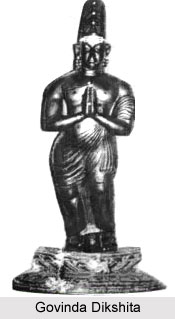 Govinda Dikshita was a brilliant scholar, polymath and the chief minister to three successive Nayaka kings of Tanjavur in the 16th century AD. The three kings under whom he served as the chief minister were Sevappa Nayaka, his son Achyutappa Nayaka and his grandson Raghunatha Nayaka.
Govinda Dikshita was a brilliant scholar, polymath and the chief minister to three successive Nayaka kings of Tanjavur in the 16th century AD. The three kings under whom he served as the chief minister were Sevappa Nayaka, his son Achyutappa Nayaka and his grandson Raghunatha Nayaka.
Govinda Dikshita has a great contribution in the administration of the ruling system and also in the spheres of religion and education. In fact without the mention of Govinda Dikshita, the history of Nayaka rule is never complete. He was a Kannada Brahmin of the Vasishta gotra and Ashvalayana sutra, who has immense contribution to the `ikshita`.
Govinda Dikshita had vast knowledge of the Hindu Sastras and astrology even at a very young age.
As per the history, Govinda Dikshita migrated to the Tamil country around the middle of the 16th century A. D. He was sent by Achyuta Raya, the Vijayanagara emperor of Hampi (Kamataka) to Sevappa Nayaka when the latter was given the Tanjavur kingdom to rule over. Due to his expertise in Advaita philosophy, Govinda Dikshita was honoured with the title `Advaita Vidya Acharya`. He was also a music lover and had great knowledge of South Indian music. As per his son, Venkateshwara Dikshita the famous treatise `Sanjjita Stidba` on South Indian music was written by Govinda Dikshita.
The Pattishwaram temple has a life-size statue of Govinda Dikshita and his wife Nagambal. His authority on the Dharma Sastras i, e, Hindu law codes is also proved by the inscriptions from this temple. Numerous charitable acts were also done by him. The great Mahamagham tank of Kumbakonam along with the `Tnandapasaji` around and also the stone steps leading to the tank were built by Govinda Dikshita. Few of the sculptures of the temple mandapa portray the king of Tanjavur honouring Govinda Dikshita by weighing him against an equal quantity of gold in a scale. These sculptors also depict that the king is then offering those gold to Govinda Dikshita to shower his affection and respect for him. He also erected many other mandapas in places like Tiruvaiyaru, Tiruvalanjuli, Tiruvidai-marudur and Vriddhachalam. He also constructed the famous Mahadana streets in Tiruvidaimarudur and Mayavaram. He developed the villages like Varahur, Eachangudi and many others and then gifted these to the scholars.
Govinda Dikshita had two sons having scholarly fame. One of his son Yajnanarayana Dikshita composed `Sahitya Ratnakara` and `Ragbunatba Vilasa Nataka` for which he is still remembered by the people.



















